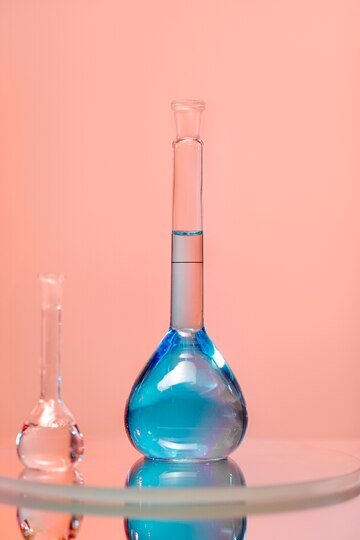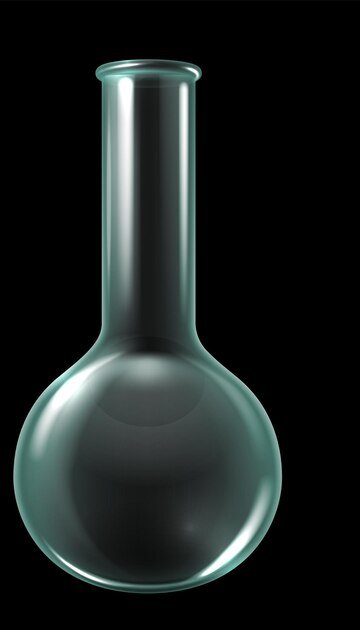Table of Contents
Introduction
In the field of scientific experiments and laboratory procedures, accuracy and precision are of the utmost importance. One of the best instruments to incorporate these qualities is the volumetric flask. Despite its simple appearance, this glassware is integral to obtaining reliable and reproducible results in countless scientific fields. From chemistry to biology, volumetric flasks play an important role in ensuring measurements are accurate, helping scientists conduct experiments with greater confidence.
What is a volumetric flask?
A volumetric flask A measuring flask or graduated flask, is a type of laboratory glassware that is calibrated to hold an accurate volume at a specific temperature. Typically, it has a flat bottom, a long neck, and a stopper to prevent the contents from spilling or becoming contaminated.

There is a line on the flask, called the calibration line, that indicates the correct volume in the neck. These volumes are usually measured in milliliters (mL) or liters (L). The design of the volumetric flask allows for accurate measurement of liquids. The narrow neck and single graduation mark make it possible to measure a specific amount of liquid accurately. This characteristic distinguishes volumetric flasks from other types of laboratory glassware, such as beakers and Erlenmeyer flasks.
Historical background
The history of the volumetric flask is linked to the development of laboratory glassware and the pursuit of precision in scientific research. The development of accurate measurement tools became important as scientific studies became more quantitative. This flask, as we know it today, was developed through a series of innovations in glassblowing and calibration techniques.
In the 19th century, advances in glassmaking allowed more precise and reliable glassware to be produced. The introduction of standardization and calibration in laboratory equipment further increased the accuracy of scientific measurements. Volumetric flasks became indispensable tools in analytical chemistry, especially in titration and preparation of solutions.
Types of Measuring Flasks
Volumetric flasks come in many different types and sizes, each designed for specific purposes. Here are some common types:
- Class A volumetric flasks: These are very accurate and are used when high accuracy is required. These are calibrated according to strict standards and have a high degree of accuracy.
- Class B Volumetric Flasks: These flasks are less accurate than Class A but are suitable for many routine laboratory tasks where absolute accuracy is not important.
- Plastic volumetric flasks: Made from materials such as polyethylene or polypropylene, these flasks are less fragile than glass and are used when working with corrosive chemicals or in environments where breakage is a concern.
- Amber volumetric flask: These flasks are made of amber-colored glass to protect the photosensitive solution from spoilage.
- Standard Volumetric Flask: These flasks are used for general purposes and come in many sizes, usually from 1 ml to 2 L.
The Importance of Accuracy
Accuracy in scientific measurements is important for several reasons. For example, in analytical chemistry, the concentration of a solution must be precisely known to determine the outcome of an experiment.
Even a small measurement error can cause significant discrepancies in results. This is particularly important in fields such as pharmaceuticals, where the exact concentration of a substance can affect the efficacy and safety of a drug.
These flasks are designed to provide this level of accuracy. A calibration mark on the neck of the flask ensures that the liquid is accurately leveled when it reaches that point. This precision is achieved through careful manufacturing processes and strict quality control measures.
Calibration and Applications
Volumetric flasks must be properly calibrated in order to be used accurately. Calibration involves marking the flask at a specific level so that it is filled to the correct level. Here are the steps to ensure proper use of a volumetric flask:
- Cleaning: The flask must be thoroughly cleaned to remove residues that could affect measurements. It is often rinsed with distilled water to ensure it contains no impurities.
- Filling: The flask is filled with liquid to a point below the calibration mark. A pipette or dropper is used to add the last few drops until the bottom of the meniscus (the curved surface of the liquid) rests exactly on the calibration line.
- Temperature considerations: Volumetric flasks are calibrated at a specific temperature, usually 20 °C. The volume of liquids can change with temperature, so it is important to use the flask at or near its calibration temperature for the most accurate results.
- Stopper: Once filled to the calibration mark, the flask is stopped and inverted several times to thoroughly mix the contents.
Applications in Various Fields
The versatility and precision of volumetric flasks make them indispensable in many scientific fields. Here are some notable applications:
Chemistry
In chemistry, this flask is used to prepare solutions with precise concentrations. Quantitative analysis requires that the exact amount of solute in a solution be known. This flask is also used in titrations where a known volume of a solution is needed to determine the concentration of an unknown substance.
Biology
In biological laboratories, volumetric flasks are used to prepare buffer solutions and media for growing cells and microorganisms. Accurate concentration is critical to maintaining the correct pH and osmotic conditions required for biological processes.
Environmental Science
Environmental scientists use volumetric flasks to prepare standard solutions to analyze pollutants in water, soil, and air. Accurate measurements are important for detecting and quantifying contaminants at trace levels.
Medicine
In the pharmaceutical industry, volumetric flasks are essential for the preparation of solutions used in drug manufacturing and quality control. The accuracy of these products ensures that the drugs are safe and effective.
Maintenance and upkeep
Proper care and maintenance of volumetric flasks are essential to ensuring their longevity and accuracy. Here are some suggestions:
Routine cleaning: After each use, the flask should be cleaned thoroughly. This prevents contamination and ensures accurate measurements for future use.
Avoiding thermal shock: Sudden temperature changes can cause the glass to break. If the vials have been stored in a cold or hot environment, they should be brought to room temperature before use.
Careful handling: Volumetric flasks are often made of glass and are fragile. They must be handled carefully to avoid breakage.
Inspect for damage: Regularly inspect the flask for any cracks or chips, especially around the calibration mark. Damaged vials should be replaced to ensure accuracy.
Innovations and Future Trends
The field of laboratory glassware, including volumetric flasks, is evolving with advances in materials science and manufacturing techniques. Innovations such as the use of more durable and chemically resistant materials improve the longevity and versatility of volumetric flasks.
Additionally, digital technologies are being integrated into laboratory processes. Electronic pipettes and digital burettes are becoming more common, and future volumetric flasks may include sensors to provide real-time digital readouts of volume and temperature, improving accuracy and ease of use.
Conclusion
The volumetric flask, with its simple and precise design, is a cornerstone of scientific experimentation. Its ability to provide accurate and reliable measurements is essential in a variety of scientific fields. From preparing standard solutions in chemistry to ensuring proper conditions in biological experiments, the volumetric flask highlights the importance of accuracy in scientific investigation.

